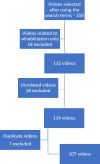Comprehensiveness and Reliability of YouTube as an Information Portal for Lumbar Spinal Fusion: A Systematic Review of Video Content
- PMID: 33900972
- PMCID: PMC7931708
- DOI: 10.14444/8023
Comprehensiveness and Reliability of YouTube as an Information Portal for Lumbar Spinal Fusion: A Systematic Review of Video Content
Abstract
Background: YouTube is a readily accessible, non-peer-reviewed video-based platform serving as a major source of online medical information presently. The aim of the current article is to analyze the comprehensiveness and reliability of the videos related to lumbar spinal fusion available on YouTube.
Methods: A YouTube search was conducted to analyze videos on lumbar spinal fusion using the search terms lumbar fusion, spinal fusion, and lumbar interbody fusion. Consequently, 107 videos met the inclusion criteria and were short-listed. Videos were analyzed for video information data, including views, likes and dislikes, views per day, likes per day and likes per view, and reliability and comprehensiveness scores.
Results: Of the 107 videos included in the study, a majority (75.7%) were found to be poor in comprehensiveness. There was no correlation found between video information data and reliability and comprehensiveness scores.
Conclusions: Patients browsing YouTube for additional medical information on lumbar spinal fusion will be presented with large volumes of poor-quality data with a majority of videos lacking important preoperative and postoperative information.
Clinical relevance: The current study provides both patients and physicians with an opportunity to understand the limitations of online content on lumbar spinal fusion available on YouTube. This knowledge about online medical information may further enhance the quality of patient-physician interaction and understanding.
Level of evidence: 5.
Keywords: Internet; YouTube; online medical information; reliability; spinal fusion; spine surgery.
This manuscript is generously published free of charge by ISASS, the International Society for the Advancement of Spine Surgery. Copyright © 2021 ISASS.
Conflict of interest statement
Figures
References
LinkOut - more resources
Full Text Sources
Other Literature Sources
Research Materials
Miscellaneous




